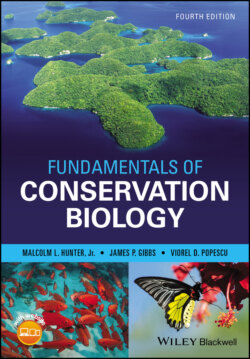Читать книгу Fundamentals of Conservation Biology - Malcolm L. Hunter Jr. - Страница 122
CASE STUDY 5.1 Galápagos Giant Tortoises
ОглавлениеThe Galápagos Archipelago in Ecuador is home to many unusual species, including Darwin’s finches, marine and land iguanas, and, perhaps their most famous inhabitants, giant tortoises. These animals are indeed giants, weighing up to 400 kg. Giant tortoises were found on most continents during the Pleistocene but now persist only on two groups of remote oceanic islands: the Galápagos and the Seychelles. Only in the Galápagos do multiple populations survive, although only some 10 species of the original 15 still survive in the wild. A major reason for their endangerment is that an estimated 200,000 tortoises were taken from wild populations starting in the seventeenth century when buccaneers and whalers collected tortoises as a source of fresh meat.
Although they have been studied for centuries, recent research on Galápagos tortoises based on modern molecular genetic techniques has catapulted our understanding, starting with a 10‐year‐long effort to survey every remaining tortoise population, archiving blood samples and extracting DNA from some 5000 individual tortoises. DNA sequencing in mitochondria as well as microsatellites was undertaken to shed light on relationships among populations and to assist with designing captive breeding programs.
What has been learned? This research revealed a new species of giant tortoise (Poulakakis et al. 2015). On the largest island of Santa Cruz people have long known of a small and nondescript population of tortoises at a remote site named Cerro Fatal. Genetic analyses revealed that the Cerro Fatal tortoises are more different from the other tortoises with which they share the island of Santa Cruz than from tortoises anywhere else in the archipelago. In other words, they likely represent an entirely separate colonization of the island and are worthy of special protection as a distinct species of tortoises. This newly described species is now receiving more attention from management authorities.
One curious pattern emerged; although most individuals in any tortoise population are quite similar genetically, certain individuals stand out as being completely different (Caccone et al. 2002). This is particularly true of a remote volcano on the northern end of Isabela Island near a harbor for sailing ships during the whaling era. Genetic analyses have now determined that this volcano holds many members of the island’s endemic species but also many “aliens” that turn out to be descendants of two extinct tortoise species, one from Pinta Island where they recently went extinct, and one from Floreana Island where they have not been seen since about 1980. They apparently were moved by whalers some 150–200 years ago and abandoned before they were killed. Now, thanks to insights from molecular genetics, we have a new option for rescuing extinct giant tortoise species and “re‐tortoising” their original islands. In fact, this process is now ongoing for Floreana Island (Fig. 5.14) (Miller et al. 2018).
Figure 5.14 An “alien” giant tortoise (a) recently discovered on a remote volcano on northern Isabela Island in the Galápagos among thousands of endemic tortoises (b). The “alien” is believed to be descended from an extinct species (the Floreana Island tortoise). This individual is being removed from the wild by helicopter to a captive rearing center on another island. This and another 20–30 such hybrid individuals are now being incorporated into the breeding program to generate offspring for restoring tortoises on Floreana Island where tortoises have not been seen for over 150 years, a process closely informed by genetic analysis (Miller et al. 2018).
(James P. Gibbs, author)
Genetic analyses have been particularly important in guiding the captive breeding programs for endangered tortoises. For the Española species, reduced to just 15 individuals before being brought into captivity for safekeeping and producing over 1000 offspring, Milinkovitch et al. (2004) used microsatellite markers in a maternity/paternity assessment of the offspring and found that the genetic contribution of the remaining adults to the offspring pool is very uneven. In other words, modifications of the breeding program are likely warranted. The analysis pointed out specifically which individual adults should be emphasized or de‐emphasized through managed pairings.
In sum, this overview illustrates for one group of creatures the many ways in which conservation genetics informs conservation practice. Similar analyses are being undertaken to guide conservation and restoration of many other imperiled species around the world.
